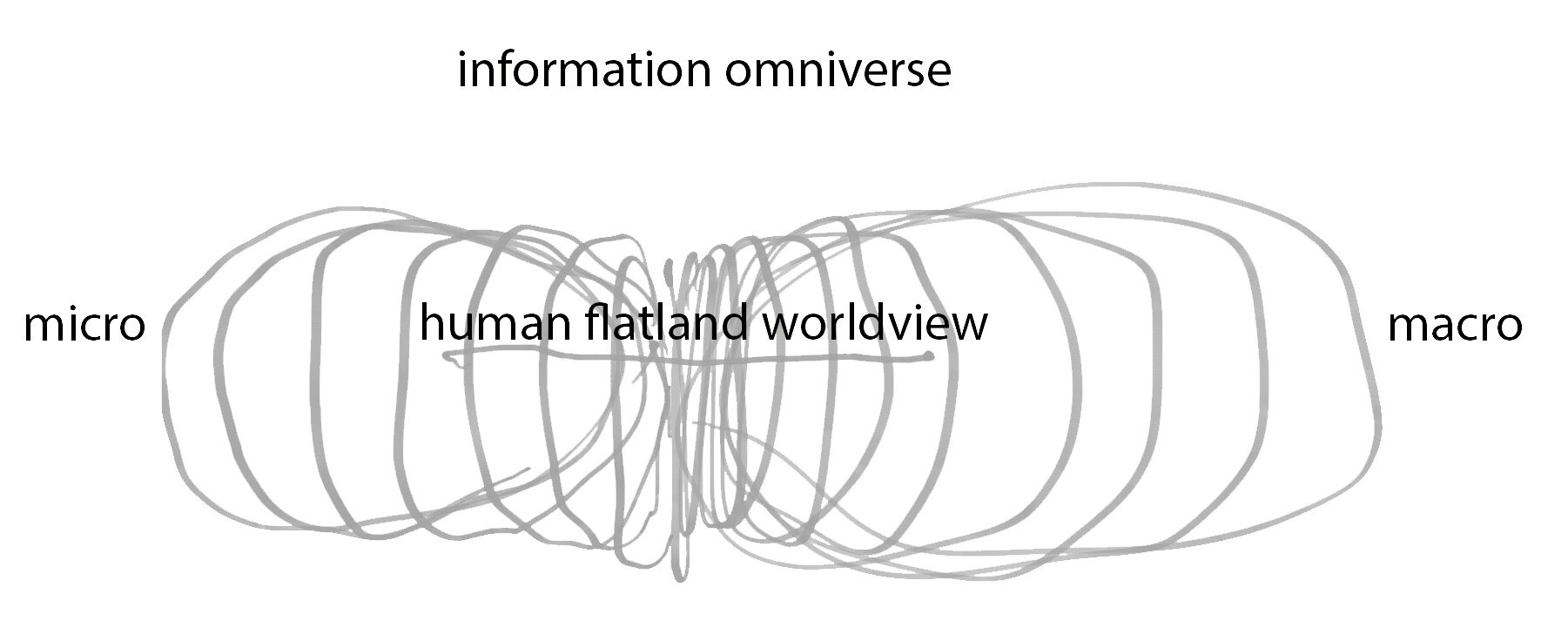
sketch of the information omniverse | Kas Oosterhuis | 2017
Powers of Ten
Knowing the Powers of Ten by Charles and Ray Eames, zooming out into the macrocosmos, zooming in into the microcosmos, the feeling which it leaves behind is the experience of vast seemingly empty spaces. Empty between the stars and galaxies, empty between the atoms and quarks. At the same time the feeling imposes on us that in effect matter does not exist, it only exists because we are built the way we are built. Meaning that we see and feel matter as matter since our sense organs are evolved as to feel what we feel, and see what we see.
The earth, the cosmos and the nano worlds are seen by our sense organs and the instruments lifeforms like people have built since ages. So this is the extended reality that is created to be seen by our eyes only. Let’s have a look at a smaller creature, for example a bacterium, what does a bacterium actually senses, feels, what does it see without having eyes? One thing is sure, they explore their environment in similar way as we do, while they see different things, they have a different worldview, not per se more restricted, but different.
Processing information
Let’s apply this methods of empathy to other scales on the bandwidth from macro cosmos to micro cosmos. What does a galaxy feel, how does it explore its environment? You may already notice that I assume that a galaxy indeed actively explores its environment. For sure it exchanges information with other nearby galaxies, for sure it absorbs information, it processes information and it sends out information in a customized format. Like any vehicle – people, bacteria, cars, atoms – a galaxy processes information.
So all people, bacteria, cars, galaxies, atoms etc are information processing vehicles, with their own particular way of seeing, feeling, sensing, living in their own information bubble, exploring their own worlds within their sensing boundaries, developing their own worldviews. At the same time they are intensively interacting with innumerate other information bubbles. This way of looking at the world, on any imaginable scale, is the basis of swarm theory, which I have embraced in my architectural theory and practice.
Back to the Powers of Ten, I have been wondering for much of my life, to start with my essays in the Dutch magazine Wiederhall in the eighties, whether the seemingly empty space on the macro scale somehow could be connected to the vast empty space on the micro scale. What is particularly difficult for our limited worldview is that we ourselves are caught in our [extended] worldview. We are sort of flatland people, not equipped to see or feel beyond flatland. Yes, we can extend flatland almost endlessly but it will never become spaceland, or any other dimension we would wish to reach out to.
Spaceland
My hunch is that that unreachable spaceland is the realm of information. Information as a primary driving force of what we may label as the omniverse, and of which we see and feel only a section. Very much like plans and sections of a building are mere one-dimensional cut-outs of an otherwise three-dimensional space, a single section can never include the amount of information the three-dimensional model has. Information as a primary driving force I consider as something similar to the concept of Richard Dawkins selfish gene. So I am tempted to develop empathy with the selfish information. Information that can not stand still, but always is on its way the be read, processed and passed on in tweaked form. Information as an executable, as suggested by Stephen Wolfram.
Omniverse
The above speculation means that we are living on a delicate membrane in an information omniverse which bridges both far ends of our extended human vision. Imagine that from our own randomly local, temporal position in the information omniverse our outward vision propagates on a curved flatland surface, as on the surface of a doughnut, climbing up and curving downward towards an imaginary equator. Now imagine the same for our inward looking vision, looking deep into each and every atom, imagine a downward curving surface of the same doughnut, eventually curving up towards its equator. Now connect the upper and lower half of the doughnut.
There we are, making ends meet, trying to live with our limited ability to understand the endless world of information. I have always had the feeling that macro cosmos and micro cosmos must be two sides of the same coin. That coin being the for us people unfathomable universe of selfish information. That coin being inflated to become an endlessly scalable doughnut. The crux of this thought experiment is that the two ends will actually merge in the world of information [but not in our flatland view, while one can imagine any life form on any location perpendicular to the surface of that doughnut. Other lifeforms are perfectly possible on other sections, forms of life that we can not see or feel, neither would we be able to understand alien crystallized form of information.
Increase in information content
This speculative thought experiments does not give a clue to what life actually is, but it teaches me that life as we know it is only one of many possible crystallized forms of accumulated information, increasing its entropy level by consuming certain crystalline forms into higher organised forms of information. In the same way as we people process food to feed our brains. The second law of thermodynamics goes hand in hand with the unlikely increase in information content. This for sure we experience on an everyday basis when we achieve something, preparing our food, designing our buildings, writing our blogs. We process information and bring it to a higher level of organisation, thus contributing to the increase of entropy of what is left behind.
It would not be overly audacious to consider information processing as the deeper form of life and assume that after a very long period of time all we sense as tangible matter will eventually be converted into an highly organised highly unlikely immaterial form of information. Than indeed what we experience as ourselves in relation to matter is in fact a transitory phase in a giant information processing machine called the information omniverse. Whatever, I like that idea, and it makes me feel perfectly at home in the universe. All we have to do is making ends meet.
